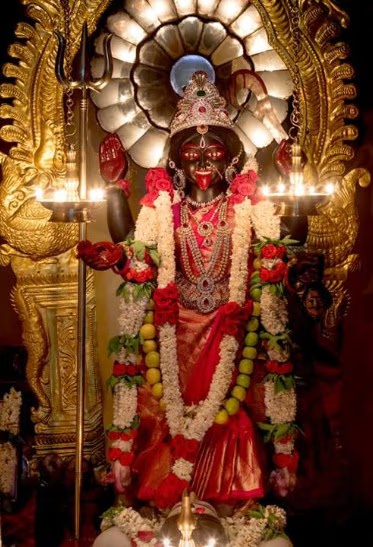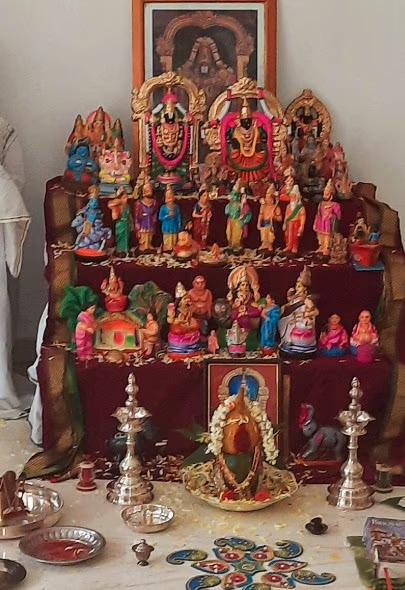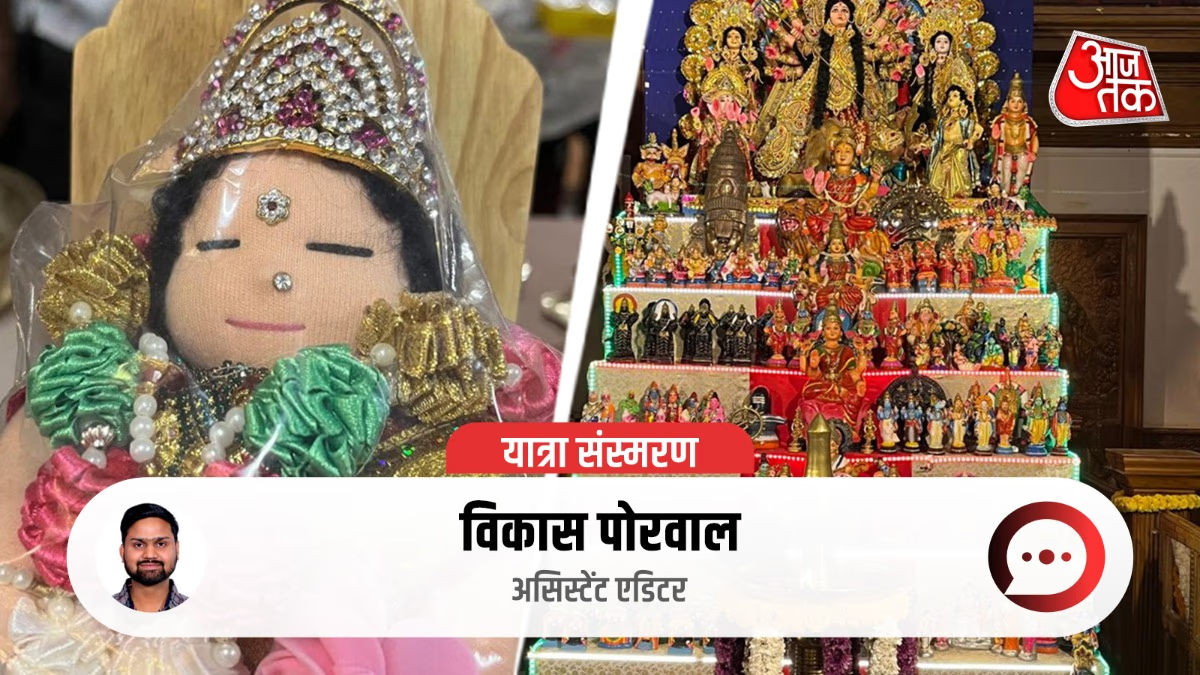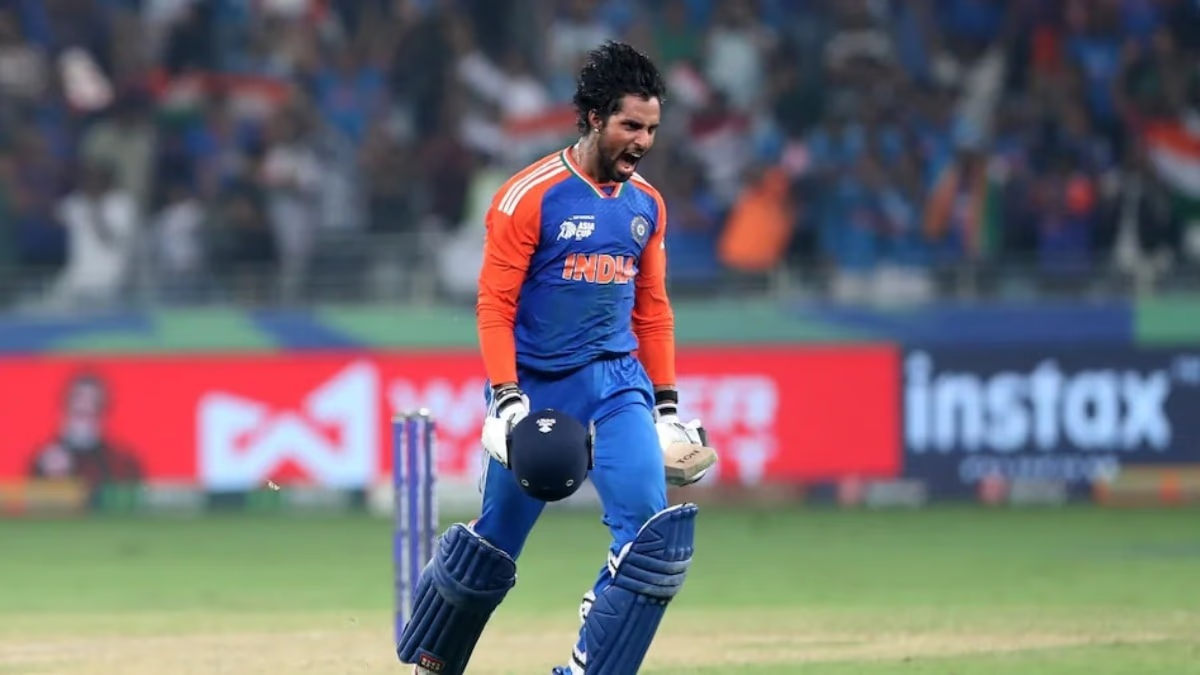As dawn was breaking, a glance at the clock showed it was 4:45 AM. Our driver, Anna, announced in Malayalam that we had arrived. Sleepy and disoriented, I stepped onto the land of Kerala, a southern state of India. The gentle, salty wind from the sea welcomed me. When I looked at Anna quizzically, he explained, 'Yes, the sea is close by.'
Scanning my surroundings, I noticed barricades on the roads marking diversions due to ongoing work. Yet, it was the melodious sound that captured my attention. Although the words were in Malayalam, the sentiment was clear. When I gestured inquiringly to Anna, he motioned toward a nearby temple, explaining, 'There's a temple nearby.'
I found myself in the town of Neendakara in Kollam district. Neendakara caught the spotlight during Rahul Gandhi's 'Bharat Jodo Yatra', surrounded by backwaters and ocean waves. However, my intrigue grew upon hearing Malayalam hymns emanating from a temple. Although I had witnessed no Durga Puja pandals resembling those that brighten North Indian towns during Navratri, the festival's nuances were just beginning to unfold.
Astonishingly, the ancient tale of Mahishasura Mardini originates from the southern state of Mysore, Karnataka. Yet, Kerala's approach to Durga Puja contrasts starkly with the influence of the Bengali Shakti tradition that permeates North India.
Later that day, I set out for my destination, which triggered this journey from Delhi to Kerala. In Amritapuri, Mata Amritanandamayi’s ashram celebrates her 72nd birthday with much grandeur, hosting various cultural programs showcasing Kerala's folk art in one beautifully coordinated space.
Surrounded by the coastal village near the ashram, I explored for answers. The winding alleys lined with small houses, each with a cottage-like roof structure, resembled tiny temples in a row from a distance.

Source: aajtak
While wandering, I noticed no overt signs of Navratri or Durga Puja. Outside a house, I met Adheera, who is connected to the fishing industry. He questioned, 'What do you need? Who are you?' (spoken in English)
After introducing myself, I asked if Dussehra-Navratri was celebrated here. Adheera clarified that while it's not widespread, it’s known and minimally observed. This was enough to understand that, at least in Kerala, there is an awareness of Navratri, Dussehra, and Vijayadashami.
The Dakshineswar Temple in Kerala
My interest in the celebration only deepened. At Mata Amritanandamayi's ashram, which itself resembles a temple with several places of worship, I noticed the Dakshineswar Kali Temple near the main entrance.
Amma herself commissioned this temple. It is said that during her meditation, she envisioned the image of the goddess from the Dakshineswar Temple in Kolkata and decided to replicate it. The temple is a replica of the Dakshineswar style, with the entrance flanked by two lion statues forming a lion gate, and a bas-relief of the mythic demon Kirtimukha on the doorway.
Inside the sanctum, a large uninterrupted lamp burns before the goddess. Draped in red, adorned with gold, she strikes a fearsome pose – one hand wielding a trident, another a sword, a severed demon head in one, while the right hand offers assurance. Her protruding tongue adds to her fierce image.
Despite this fierce form, Maha Kali appears serene with a gesture of reassurance. Surrounding the sanctum are smaller deity statues and a representation of Shiva as Bhairava. The Shakti tradition is marked by the ritual application of red-yellow round sandalwood paste at this Dakshineswar Kali temple.

Source: aajtak
Decorated Stepped Displays in the Temple Complex
Amidst this mesmerizing setting, my eyes caught a beautifully decorated stepped display to one side in the temple. This exhibit, comprised of about 11 steps, displayed various divine figurines on each level, some handmade, others crafted from wood, adorned like dolls, with some made of clay, embodying divine figures such as Shiva, Vishnu, Kali, and the mighty divine triad.
I inquired, 'What is this?' Vishnu Prasad, a manager at Amritapuri Ashram familiar with Hindi, explained, 'This is Golu. It's also known as Bommai Golu.'
His brief response started unfolding the answers to my questions. I had found the perfect place for my inquiry.
I asked, 'What is Golu? What does it mean?'
'Golu is the name for divine hand-crafted figurines. Initially crafted at home, they're now more often purchased from the market and displayed,' explained Vishnu.
Why so?' I further inquired.
Vishnu replied, 'These are the nine days, you know...'
When I suggested, 'Navratri?', Vishnu confirmed with a nod. Indeed, during Navratri in Kerala, symphonic displays called Golu, or Bommai Golu, are arranged, and this is known as Bommai Golu – possibly deriving from the words for deity or mother. Golu, or Kolu, means dolls, and Bommai Golu translates to a court of dolls. In essence, it resembles the displays witnessed during Krishna Janmashtami in North India.
Golu Displayed in Many Temples
Though I gathered some information from Vishnu Prasad, it was in various temple settings that I observed Golu displays. Each was similarly arranged, with step-by-step adornment of divine figures. Upon closely examining Golu displays, the figures might not always resemble deities. Often, identifying the figures was challenging.
Frequently, the number of steps varied from three to five, and sometimes even nine or eleven. As the stairway expanded, so did the grandeur and characters within the Golu displays.

Source: aajtak
Bommai Golu Displayed with Varied Steps
During one Golu exhibit, I saw a lower tier featuring fish, followed by turtles on the next level, then winding its way up through snakes and trees, and then humans, such as farmers working in fields, with the next level showcasing sages, followed by divine figures. Some recognizable figures included Radha-Krishna or Rama with Hanuman, but many remained ambiguous.
No one I spoke with could fully explain these figurines or the connection between Bommai Golu and Navratri. Language posed a significant barrier, as English wasn't precise enough for traditional and cultural discussions, and I lacked understanding of Malayalam.
After photographing Golu displays, I continued my exploration. Yet another temple emerged along my route. This time, I saw a five-stepped Golu exhibit. It became apparent that Golu displays were predominantly temple-associated, with people visiting these locales to view the exhibits.
Golu Displays Predominantly at Temples
Does the tradition of setting up Golu exist in homes too? This became my next inquiry. Roaming the alleys, I peeked into homes but saw no signs. When I asked if they had Golu at home, responses like 'no' indicated they didn’t understand or didn’t practice the display. The individuals appeared low-income, possibly unable to afford home displays.
Continuing my search and questions, I revisited the temple with the grand 11-stepped Bommai Golu display. Situated atop the highest step, a Mahishasura Mardini idol, reminiscent of the ones seen in North Indian pandals, was a comforting sight, truly relating Bommai Golu with Navratri celebrations.
Nonetheless, questions regarding underlying meanings remained. Then, I noticed a woman tending to the display’s lamp wick. I greeted her, sharing my introduction, continuing our dialogue in English. Upon asking about the display’s significance, she asked my origin.
'From Delhi,' I replied.
'I lived in Kolkata,' she shared. 'My name is Deepa, I’m a faculty member here at Amrita Vidyapeetham.' Deepa's roots are steeped in Kerala and her experiences in Kolkata allowed her to grasp the Shakti tradition’s Durga Puja, comprehending both cultures and offering valuable insights.
When queried about Navratri's celebration in Kerala, Bommai Golu, and its ceremonial meanings, Deepa elaborated, 'Here in the South, especially Kerala, Navratri isn’t observed like Kolkata’s nine goddess worship or North India's vibrant festivities. We have the nine days, starting with the first three days honoring Parvati, followed by three days devoted to Lakshmi, culminating in the final three days reserved for Saraswati.'
‘From the first Navratri, Bommai Golu displays are arranged, mostly collaboratively within temples, although some individuals decorate Golu at home. These stairs you observe signify our progress—personal, spiritual, and in life and nature. Each step reflects an ascent in advancement and enlightenment.'

Source: aajtak
Do these portray all deities?
Deepa explained, 'No, they don’t represent all deities. The first tier features earthly beings—our needs and possessions. Above are greater forces like the sun, moon, planets, and stars, followed by divine entities like Krishna, Rama, Shiva, and Ganesh. The layer above hosts goddesses such as Lakshmi, Saraswati, Kali, with Vishnu’s avatars proceeding, crowned by Adi Shakti, the supreme goddess.'
Upon further inquiry about the custom of girl worship akin to Bengali or North Indian traditions, Deepa negated its occurrence, although Vijayadashami marks a day of significant Saraswati worship in Kerala, celebrating with offerings, white flowers, and rice. It symbolizes Durga Puja in the North, while in Kerala, it represents Saraswati Puja. People perform Ayudha Puja too, honoring the objects aiding in their tasks.
Emphasizing, 'Ayudha symbolizes all useful items—from gardening tools to educators and students revering pens; kitchenware to vehicles, culminating in weaponry and military equipment.'
Saraswati Puja Holds Eminence
However, the day dedicated to Saraswati Puja is paramount. Children introduced to education participate as their palms are marked with rice powder imprints of Goddess Saraswati’s mantra or the 'Om' symbol. Married women receive sarees and clothes as gifts, while girls receive doll gifts during the occasion.
Is the tradition of Golu arrangement emulated in every South Indian household during Navratri? ’ No, as Deepa explained, it stems from caste-based traditions, historically held by Brahmin families showcasing Golu and inviting people to view their displays, receive offerings, and participate in festivity, unlike warrior (Kshatriya) and merchant (Bania) classes initially abstaining from Golu setups.
Kerala’s heritage venerates Bommai Golu’s cultural legacy, intertwining ancient practices with contemporary symbols. These stepped displays embody societal history, showcasing figures like Mahatma Gandhi, Akkama Cherian, and K. Kelappan, celebrating Navratri’s nine days through a unique cultural lens in Kerala.




